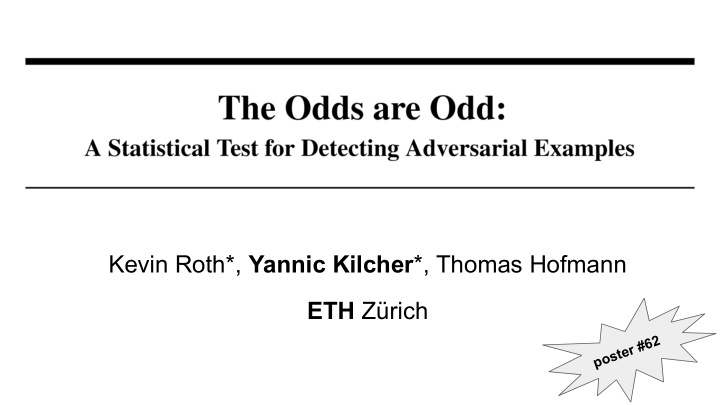



Kevin Roth*, Yannic Kilcher *, Thomas Hofmann ETH Zürich 2 6 # r e t s o p
Log-Odds & Adversarial Examples
Log-Odds & Adversarial Examples Adversarial examples cause atypically large feature space perturbations along the weight-difference direction
Adversarial Cone x*
Adversarial Cone x* x adv
Adversarial Cone x* random x adv
Adversarial Cone P y* (.) = 1 x* random x adv P y* (.) = 0
Adversarial Cone P y* (.) = 1 x* random x adv P y* (.) = 0
Adversarial Cone P y* (.) = 1 x* x adv P y* (.) = 0 Adversarial examples are embedded in a cone-like structure
Adversarial Cone softmax x adv + t noise *
Adversarial Cone softmax x adv + t noise *
Adversarial Cone softmax x adv + t noise * Noise as a probing instrument
Main Idea: Log-Odds Robustness The robustness properties of are different dependent on whether or tends to have a characteristic direction if whereas it tends not to have a specific direction if
Main Idea: Log-Odds Robustness natural adversarial Noise can partially undo effect of adversarial perturbation and directionally revert log-odds towards the true class y*
Statistical Test & Corrected Classification We propose to use noise-perturbed pairwise log-odds to test whether classified as should be thought of as a manipulated example of true class : adversarial if Corrected classification :
Detection Rates & Corrected Classification ● Our statistical test detects nearly all adversarial examples with FPR ~1% ● Our correction method reclassifies almost all adversarial examples successfully ● Drop in performance on clean samples is negligible
Detection Rates & Corrected Classification attack strength ε Detection rate increases with increasing attack strength Corrected classification manages to compensate for decay in uncorrected accuracy due to increase in attack strength
Defending against Defense-Aware Attacks ● Attacker has full knowledge of the defense : perturbations that work in expectation under noise source used for detection Detection rates and corrected accuracies remain remarkably high
Thank You poster #62 Kevin Roth Yannic Kilcher Thomas Hofmann Follow-Up Work: Adversarial Training Generalizes ICML Workshop on Data-dependent Spectral Norm Regularization Generalization (June 14)
References The approaches most related to our work are those that detect whether or not the input has been perturbed, either by detecting characteristic regularities in the adversarial perturbations themselves or in the network activations they induce. ● Grosse, Kathrin, et al. "On the (statistical) detection of adversarial examples." (2017). ● Metzen, Jan Hendrik, et al. "On detecting adversarial perturbations." (2017). ● Feinman, Reuben, et al. "Detecting adversarial samples from artifacts." (2017). ● Xu, Weilin, David Evans, and Yanjun Qi. "Feature squeezing: Detecting adversarial examples in deep neural networks." (2017). ● Song, Yang, et al. "Pixeldefend: Leveraging generative models to understand and defend against adversarial examples." (2017). ● Carlini, Nicholas, and David Wagner. "Adversarial examples are not easily detected: Bypassing ten detection methods." (2017). ● … and many more
Recommend
More recommend